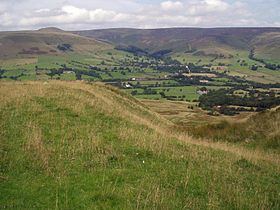Prominence 496.6 m (1,629 ft) Elevation 636 m | Pronunciation /ˈkɪndər ˈskaʊt/ OS grid SK084875 | |
 | ||
Translation Water over the edge (Old Norse) Similar | ||
Peak district walk kinder scout jacob s ladder the official summit
Kinder Scout is a moorland plateau and National Nature Reserve in the Dark Peak of the Derbyshire Peak District in England. Part of the moor, at 636 metres (2,087 ft) above sea level, is the highest point in the Peak District, the highest point in Derbyshire, and the highest point in the East Midlands. In excellent weather conditions the city of Manchester and the Greater Manchester conurbation can be seen, as well as Winter Hill near Bolton, and the mountains of Snowdonia in North Wales.
Contents
- Peak district walk kinder scout jacob s ladder the official summit
- Map of Kinder Scout High Peak UK
- Peak district walk kinder scout crowden clough kinder gates the downfall
- Public access
- Kinder Downfall and gritstone edges
- View
- Edale Cross
- Mermaid legend
- References
Map of Kinder Scout, High Peak, UK
To the north across the Snake Pass lie the high moors of Bleaklow and Black Hill, which are of similar elevation.
Kinder Scout featured on the BBC television programme Seven Natural Wonders (2005) as one of the wonders of the Midlands, though Kinder Scout is considered by many to be in Northern England, lying between the cities of Manchester and Sheffield.
The history and meaning of the name have been studied by Broderick. In chronostratigraphy, the British sub-stage of the Carboniferous period, the 'Kinderscoutian' derives its name from Kinder Scout.
Peak district walk kinder scout crowden clough kinder gates the downfall
Public access
Kinder Scout is accessible from the villages of Hayfield and Edale in the High Peak of Derbyshire. It is a popular hiking location and the Pennine Way crosses Kinder Scout and the moors to the north. This has resulted in the erosion of the underlying peat, prompting work by Derbyshire County Council and the Peak District National Park to repair it, in conjunction with the landowner, the National Trust.
Historically, the plateau was the target of the mass trespass in 1932. From the National Park's inception, a large area of the high moorland north of Edale was designated as 'Open Country'. In 2003, the "right to roam" on uncultivated land was enshrined into law, and this area of open country has been significantly extended.
Parts of the Kinder Scout plateau (except legal rights of way) are still occasionally closed for conservation, public safety, grouse shooting or fire prevention reasons, but prior notice is generally given on the Peak District National Park Authority's website.
Kinder Downfall and gritstone edges
Kinder Downfall is the tallest waterfall in the Peak District, with a 30-metre fall. It lies on the River Kinder, where it flows west over one of the gritstone cliffs on the plateau edge. The waterfall was formerly known as Kinder Scut, and it is from this that the plateau derives its name. Although usually little more than a trickle in summer, in spate conditions it is impressive. In certain wind conditions (notably when there is a strong westerly wind), the water is blown back on itself, and the resulting cloud of spray can be seen from several miles away. Below the Downfall the River Kinder flows into Kinder Reservoir. In cold winters the waterfall freezes providing local mountaineers with an icy challenge that can be climbed with ice axes, ropes and crampons.
Some of Kinder's many gritstone cliffs were featured in the first rock-climbing guide to the Peak District, Some Gritstone Climbs, published in 1913 and written by John Laycock.
View
Major English and Welsh peaks visible (in ideal conditions) from Kinder Scout include (clockwise from west) Winter Hill (31 miles), Pendle Hill (38 miles), Ingleborough (58 miles), Whernside (62 miles), Pen-y-ghent (56 miles), Fountains Fell (54 miles), Buckden Pike (57 miles), Great Whernside (54 miles), Bleaklow (5 miles), Margery Hill (8 miles), the Weaver Hills (26 miles), Axe Edge (11 miles), The Roaches (16 miles), Shutlingsloe (13 miles), Shining Tor (10 miles), the Long Mynd (71 miles), Stiperstones (71 miles), Corndon Hill (74 miles), Cilfaesty Hill (88 miles), Moel y Golfa (68 miles), Plynlimon (102 miles), Cadair Berwyn (72 miles), Beeston Castle (38 miles), Alderley Edge (15 miles), Arenig Fawr (84 miles), Moel Famau (60 miles), Snowdon (94 miles), Glyder Fach (91 miles), Tryfan (90 miles), Y Garn (92 miles), Carnedd Llewelyn (88 miles) and Foel-fras (87 miles).
Edale Cross
The Edale Cross lies immediately south of Kinder Scout, under Kinder Low and on the former Hayfield to Edale road. It marks the former junction of the three wards of the Forest of Peak: Glossop and Longdendale, Hopedale and Campagna. The first cross on the site may have been set up by the Abbots of Basingwerk Abbey to mark the southern boundary of their land, granted in 1157. The date of the current cross is unknown, although a plaque beside it claims it to be mediaeval. At some point it fell down, and was re-erected in 1810, when the date and initials JG, WD, GH, JH and JS were carved into it. These stand for John Gee, William Drinkwater, George and Joseph Hadfield and John Shirt, local farmers of the day who raised the cross. The cross is a Scheduled Ancient Monument.
Mermaid legend
Mermaid's Pool, a small pool on Kinder Scout, is said to be inhabited by a mermaid who will grant immortality upon whoever sees her on Easter Eve.
